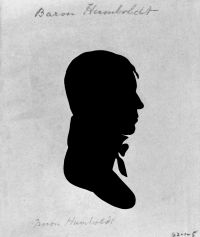Alexander von Humboldt (Silhouette)
Artist/Maker: Unknown
Created: 1804
Origin/Purchase: Peale's Museum, Philadelphia
Materials: paper embossed "Peale"
Dimensions: 7.6 × 4.4 (3 × 1 3/4 in.)
Provenance: Charles Willson Peale; by gift to Thomas Jefferson; by descent to Virginia and Nicholas Trist; by descent to Charles, James, and John Eddy; by gift to the Thomas Jefferson Foundation in 1962
Accession Number: 1962-1-5
Historical Notes: Inspired by the Prussian explorer Alexander von Humboldt's desire to meet Jefferson, Charles Willson Peale led a delegation composed of Humboldt and his partner, Aimé Bonpland, and two physicians, Nicholas Collin and Anthony Fothergill, from Philadelphia to the President's House, arriving on June 1, 1804. Peale recorded every detail of his trip in his diary, including their several visits with Jefferson. Peale presented Jefferson with this group of silhouettes during one of their visits:
I had brought with me sundry Profiles of the Baron and of the Doctr Fothergill and myself-Doctr Collin, these I destributed to such Persons as I thought they would be most acceptable.[1]
Although Peale's diary entry mentions a silhouette of himself, none from Jefferson's collection are known to survive.[2]
Humboldt had just completed his famous explorations in South and Central America, accompanied through South America by the botanist Bonpland, who had collected plant specimens. When he arrived in the United States, Humboldt requested a meeting with Jefferson, and wrote "testifying to the great admiration your writing, actions, and breadth of ideas have inspired in me since childhood."[3] Jefferson was more than happy to oblige, congratulating Humboldt on the success of his travels and writing:
[T]he countries you have visited are of those least known, and most interesting, and a lively desire will be felt generally to recieve the information you will be able to give. no one will feel it more strongly than myself, because no one perhaps views this new world with more partial hopes of it’s exhibiting an ameliorated state of the human condition.[4]
The boundaries with Spanish possessions were of immediate importance to Jefferson following the Louisiana Purchase, and Humboldt's providential visit supplied him with the data he needed to compose his fall congressional message on negotiations with Spain over Louisiana, Mobile, and the Mexican border.[5] Humboldt and Jefferson intermittently corresponded on scientific and political subjects for the remainder of Jefferson's life.
- Text from Stein, Worlds, 211-12
Further Sources
- Botting, Douglas. Humboldt and the Cosmos. New York: Harper & Row, 1973.
- Walls, Laura Dassow. The Passage to Cosmos: Alexander von Humboldt and the Shaping of America. Chicago: University of Chicago Press, 2009.
- Search for more sources on Alexander von Humboldt in the Thomas Jefferson Portal.
References
- ^ Charles Willson Peale, Diary 20, Part 1: "A Journey to Washington, D.C. and Return, Including Baltimore and Annapolis, Maryland," in Charles Willson Peale, Selected Papers of Charles Willson Peale and His Family, ed. Lillian B. Miller (New Haven: Yale University Press, 1983), vol. 2, pt. 2, 699-700.
- ^ The identities for the above silhouettes are based upon descriptions by Jefferson family members. The silhouette labeled "Bonpland" is puzzling because it has a different stamp than the other three and is not mentioned by Peale as one of the silhouettes that he brought with him on the trip.
- ^ Humboldt to Jefferson, May 24, 1804, in PTJ, 43:478-82. Transcription available at Founders Online.
- ^ Jefferson to Humboldt, May 28, 1804, in PTJ, 43:501. Transcription available at Founders Online.
- ^ See Helmut de Terra, "Alexander von Humboldt's Correspondence with Jefferson, Madison, and Gallatin," Proceedings of the American Philosophical Society 103 (1959): 786.
